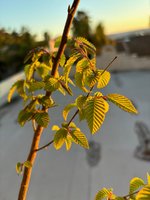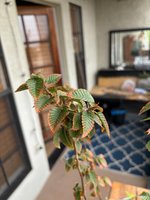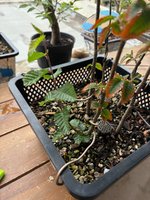zeejet
Mame
I have some Korean hornbeam seedlings that pushed new growth in March/April but have not grown at all since then. They have been properly watered with mild fertilizer application throughout the year but were watered with very hard water from January through June - I eventually got an RO system and shadecloth but I think the damage is done. There is moderate leaf scorch on all of them.
The only exception is one of the seedlings is currently sending a side shoot but the rest of the tree and all other seedlings seem entirely dormant. It’s only about 80F here in coastal San Diego throughout the summer (occasional heat spikes or dry winds from inland) so I doubt it’s summer dormancy. The shoot seems healthy and does not burn (it pushed AFTER I switched to RO and installed 40% shadecloth).
What could be preventing further growth on the rest of the seedlings? I know KH are slow growers but is it really “single flush”? Or is my horticulture completely off?
I also recognize that KH is not likely to thrive here in my climate (Zone 10b - I only realized this after purchasing them) - could that be a reason? The seedlings were shipped from NY in the spring so they should have had proper dormancy at least going into this season.
Any insight would be appreciated.
Spring growth:

Scorched spring growth:

Healthy side-shoot:

The only exception is one of the seedlings is currently sending a side shoot but the rest of the tree and all other seedlings seem entirely dormant. It’s only about 80F here in coastal San Diego throughout the summer (occasional heat spikes or dry winds from inland) so I doubt it’s summer dormancy. The shoot seems healthy and does not burn (it pushed AFTER I switched to RO and installed 40% shadecloth).
What could be preventing further growth on the rest of the seedlings? I know KH are slow growers but is it really “single flush”? Or is my horticulture completely off?
I also recognize that KH is not likely to thrive here in my climate (Zone 10b - I only realized this after purchasing them) - could that be a reason? The seedlings were shipped from NY in the spring so they should have had proper dormancy at least going into this season.
Any insight would be appreciated.
Spring growth:

Scorched spring growth:

Healthy side-shoot:


